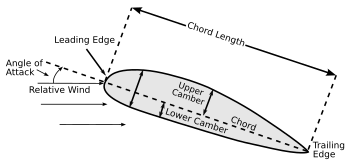Truth is, I don't think about camber lines, or chord lines (which was the correct answer) when I'm flying. One of the things I try to stress in my presentations to youth groups is that if there is something you really want to do in life you will be more inclined to push yourself thru those undesirable study subjects to be able to get there. You can't be a doctor without studying biology, but chances are unlikely you'll dissect another frog. This is a building block of eventual knowledge.
So, having been shamed by my incorrect answer, I have followed a link that another helpful flight instructor provided to refresh my knowledge on Airfoil Geometry. I will make this quick and painless, I promise.
See that little diagram to the left on this illustration? This term will come up again. That is showing the Angle of attack (AOA, α, Greek letter alpha) is a term used in aerodynamics to describe the angle
 between the chord line of an airfoil and the vector representing the relative motion between the airfoil and the air. It can be described as the angle between where the chord line of the airfoil is pointing and where the incoming air is going .
between the chord line of an airfoil and the vector representing the relative motion between the airfoil and the air. It can be described as the angle between where the chord line of the airfoil is pointing and where the incoming air is going .The caption for the diagram above is: NACA 4 digit and 5 digit airfoils were created by superimposing a simple meanline shape with a thickness distribution that was obtained by fitting a couple of popular airfoils of the time: y = ±(t/0.2) * (.2969*x0.5 - .126*x - .3537*x2 + .2843*x3 - .1015*x4) The camberline of 4-digit sections was defined as a parabola from the leading edge to the position of maximum camber, then another parabola back to the trailing edge.

Yeah, that doesn't help me either. I need a Wikipedia definition! So let's start with just talking about what an airfoil is. Simply put, an airfoil is the shape of a wing or blade (of a propeller, rotor or turbine) or sail as seen in cross-section.
Here is some Airfoil terminology:
The mean camber line is a line drawn midway between the upper and lower surfaces.
The chord line is a straight line connecting the leading and trailing edges of the airfoil, at the ends of the mean camber line.
The chord is the length of the chord line and is the characteristic dimension of the airfoil section.
The maximum thickness and the location of maximum thickness are expressed as a percentage of the chord.
For symmetrical airfoils both mean camber line and chord line pass from centre of gravity of the airfoil and they touch at leading and trailing edge of the airfoil.
The aerodynamic center is the chord wise length about which the pitching moment is independent of the lift coefficient and the angle of attack.
The center of pressure is the chord wise location about which the pitching moment is zero.
Your hand is like "Any object with an angle of attack in a moving fluid, such as a flat plate, a building, or the deck of a bridge, will generate an aerodynamic force (called lift) perpendicular to the flow. Aerofoils are more efficient lifting shapes, able to generate more lift (up to a point), and to generate lift with less drag." You may have heard how an airplane can stall. This is because "With increased angle of attack, lift increases in a roughly linear relation, called the slope of the lift curve. At about eighteen degrees this aerofoil stalls and lift falls off quickly beyond that." In other words, the airfoil stops producing lift and the airplane stops flying.
This last paragraph is what most pilots take away from the study of airfoils. If you don't know how this works, you may find yourself in trouble. I'll have to do a seperate entry about stalls. Stay tuned, and as always, let me know if I have been wrong/incomplete/unclear. Thanks!
No comments:
Post a Comment